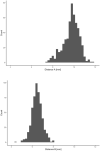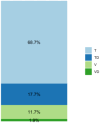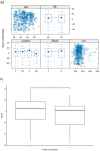Multivariate analysis of the exact effects of scalar position and insertion angle on speech discrimination
- PMID: 40534745
- PMCID: PMC12175773
- DOI: 10.3389/fneur.2025.1569100
Multivariate analysis of the exact effects of scalar position and insertion angle on speech discrimination
Abstract
Objective: Several studies examined the influence of cochlear morphology on scalar position of the electrode array and rate of dislocation. Furthermore, researchers described better speech discrimination for patients with electrode arrays positioned in scala tympani but in small study cohorts. The aim of this study is to examine the exact impact of scalar position, dislocation and angular insertion depth on postoperative speech perception.
Design: We identified the patients (n = 531) implanted between 2003 and 2018 with a Contour Advance electrode array (CochlearTM) inserted via cochleostomy by a retrospective review of the Cochlear Implant Database and analyzed the postoperative imaging by cone beam computed tomography and the audiological protocol via a multivariate nonparametric analysis.
Results: The multivariate nonparametric analysis of this study shows, that the dislocation of the electrode array and the insertion angle leads to no significant different postoperative speech discrimination results. Nevertheless, we could calculate a statistically significant amount of reduced speech recognition for monosyllables for primary scala tympani vs. scala vestibuli insertions (7.6%).
Conclusion: This study, based on one of the largest study cohorts published to date, demonstrates reduced speech recognition for scala vestibuli insertions compared to scala tympani insertions. Insertion into the scala vestibuli results in a 7.6% decrease in speech discrimination for monosyllables.
Keywords: cochlear coverage; cochlear implant; perimodiolar array; scala tympani; scala vestibuli; scalar position; speech perception.
Copyright © 2025 Beck, Aschendorff, Arndt and Ketterer.
Conflict of interest statement
The authors declare that the research was conducted in the absence of any commercial or financial relationships that could be construed as a potential conflict of interest.
Figures




References
-
- Lazard DS, Vincent C, Venail F, Van de Heyning P, Truy E, Sterkers O, et al. Pre-, per- and postoperative factors affecting performance of postlinguistically deaf adults using cochlear implants: a new conceptual model over time. PLoS One. (2012) 7:e48739. 10.1371/journal.pone.0048739 - DOI - PMC - PubMed
LinkOut - more resources
Full Text Sources

